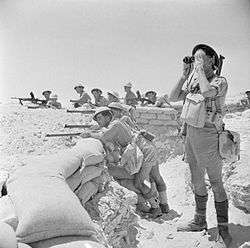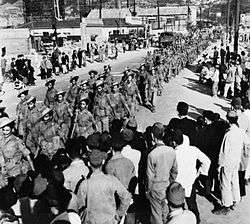Khaki drill


Khaki drill or KD was the term for a type of fabric and the British military uniforms made from them.
History
Uniform of Khaki color was first introduced in 1848 in the Corps of Guides that was raised in December 1846 as the brainchild of Sir Henry Lawrence (1806–1857) Resident at Lahore, and Agent to the Governor-General for the North-West Frontier. Lawrence chose as its commandant Sir Harry Lumsden supported by William Stephen Raikes Hodson as Second-in-Command to begin the process of raising the Corps of Guides for frontier service from British Indian recruits at Peshawar. Initially the border troops were dressed in their native costume, which consisted of a kurta and white pajama trousers made of a coarse home-spun cotton, and a cotton turban, supplemented by a leather or padded cotton jacket for cold weather. For the first year (1847) no attempt was made at uniformity. Subsequently in 1848 Lumsden and Hodson decided to introduce a drab (khaki) uniform which Hodson commissioned his brother in England to send them – as recorded in Hodson's book of published letters: "Twelve Years of a Soldier's Life in India", first published in 1859. It was only at a later date, when supplies of drab (khaki) material was unavailable, did they improvise by dying material locally with a dye. As well as the Corps of Guides, other regiments in India soon adopted the uniform and eventually it was used throughout the British military.
Khaki Drill was worn as a combat uniform from 1900 to 1949 and was most often used in desert and tropical service. A variant, still referred to a Khaki Drill or KD's, is worn by the UK Armed Forces in noncombatant warm weather countries where the British are actively serving (e.g. personnel stationed at R.A.F. Akrotiri in Cyprus will wear any of four working variants of this uniform). Generally KD was a series of different uniform patterns of light khaki cloth, generally cotton, first worn by British and British Empire soldiers in the Boer War. Canada developed its own pattern after the First World War, and the uniform was commonly worn in Canada, with officers again having the option of finer garments privately purchased. In the Second World War, Canadians serving in Jamaica and Hong Kong wore Canadian pattern KD; the I Canadian Corps troops in Italy wore KD supplied in theatre by the British, generally of British, Indian or US (War Aid) manufacture.
North Africa and the Mediterranean

In the early campaigns in North Africa and the Mediterranean theatre, British troops wore khaki drill (KD) shorts or slacks with long sleeved Aertex shirts. The tan color, paler shade of KD was more suited to desert or semi-desert regions than the "dark khaki" or brown serge used in Battle dress. When the Allies moved up through Italy, however, two-piece khaki denim battledress overalls were increasingly preferred. By 1943, the KD shirt began to be replaced by a more durable cotton KD bush jacket.
Far East

In the Far East, the British found themselves at war with the Japanese while equipped with the impractical KD uniform. Shirts and trousers had to be dyed green as a temporary expedient until more suitable jungle clothing became available. A new tropical uniform in Jungle Green (JG) was quickly developed – a JG Aertex battledress blouse, a JG Aertex bush jacket (as an alternative to the blouse) and battledress trousers in JG cotton drill. In the hot and humid conditions of Southeast Asia, JG darkened with sweat almost immediately.[1]
Post World War II

The khaki battledress was used until the late 1960s, and various uniform items in KD, JG and OG remained on issue to soldiers serving in the Mediterranean, Middle East or tropics after the war. By the end of the 1940s, however, stocks were becoming depleted, and a new 1950-pattern tropical uniform was made available in both KD and JG. It was poorly designed, with an ill fitting bush jacket in the much-maligned Aertex, and suspender buckles that dug in to the hips when marching in full kit. Eventually the much more practical Gurkha regiments’ JG shirt was copied, replacing the 1950-pattern bush jacket. All the same, troops still sought out the older, wartime, issues of the better KD, JG and OG kit.
Notes
References
- "Twelve Years of a Soldier's Life in India, from the letters of Major WSR Hodson" by G. Hodson (London) 1859.
- DPM: Disruptive Pattern Material by Hardy Blechman and Alex Newman, DPM Ltd. (2004) ISBN 0-9543404-0-X
- Behrens, Roy R. (2002). FALSE COLORS: Art, Design and Modern Camouflage. Bobolink Books. ISBN 0-9713244-0-9.
- Khaki: Uniforms of the CEF by Clive M. Law (Service Publications, 1998).
- Dressed to Kill: Canadian Army Uniforms in World War Two by Michael Dorosh (Service Publications, 2001). ISBN 1-894581-07-5
- "Khaki Uniform 1848-49: First Introduction by Lumsden and Hodson", Journal of the Society for Army Historical Research, pp 341–347; JSAHR 82 (Winter 2004)
- Khaki Drill and Jungle Green: British Army Uniforms in the Mediterranean & Asia 1939-1945, In Color Photographs by: Richard Ingrams and Martin Brayley, 144 pages Crowood Press (UK) ISBN 978-1-86126-360-5
External links
- www.canadiansoldiers.com: extensive discussion of Canadian Army uniforms, insignia, and traditions from 1900-2000
- Site which offers KD reproductions
- Canadian forces Military Police Museum site, with many pictures


.svg.png)
